Chicago Tribune (August 2000) - source - Bob Chaney (65)
(Not available on public website - in ../AA_Extra/BigGEb_00demolish.jpg)
Demolition Pictures - September 2000 - source Bob Doyle ('64) (email)
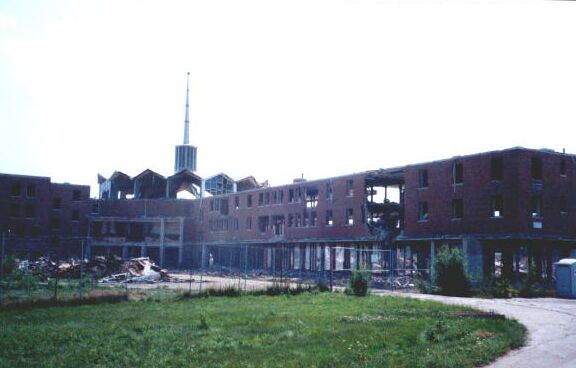
GE Demolition Leaves Nothing But Memories... and a 25.3-Acre Park
On 13 October 1999, after an 18-month struggle, the Glen Ellyn Park
District won the right to purchase the property of the former
Maryknoll College for $5.3 million. The Park District must now find
the funds to turn the campus into a park for the village and
neighborhood. Plans are to build two baseball fields, two
soccer/football fields, and a playground on the grounds of the
52-year-old former seminary. (The site owners, Maryknoll Restoration,
had weighed another offer from Red Seal of Northbrook to develop the
25.3-acre site into single-family homes and townhouses).
Demolition of the 331,000-square-foot edifice began in August 2000
-at a cost of $1 million - and was scheduled to be completed by the
middle of December 2000. The park district estimates that it will take
three to five years to complete work on the park.
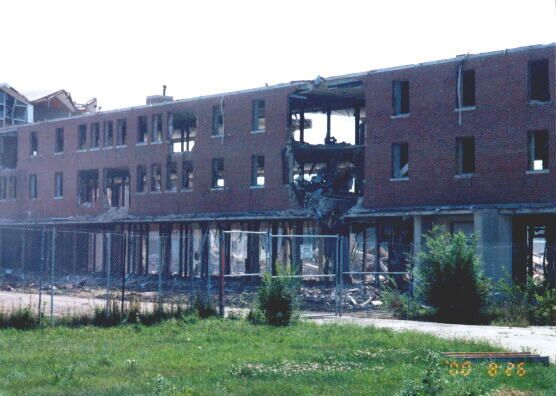
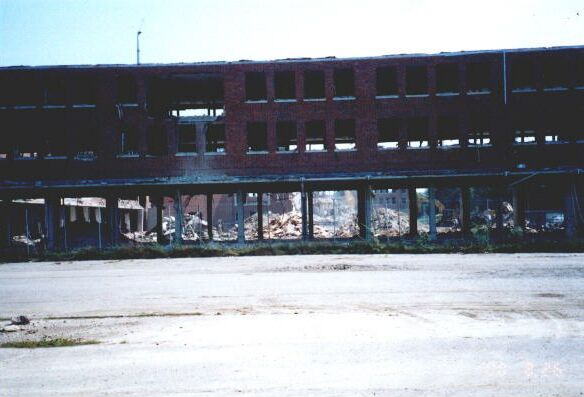
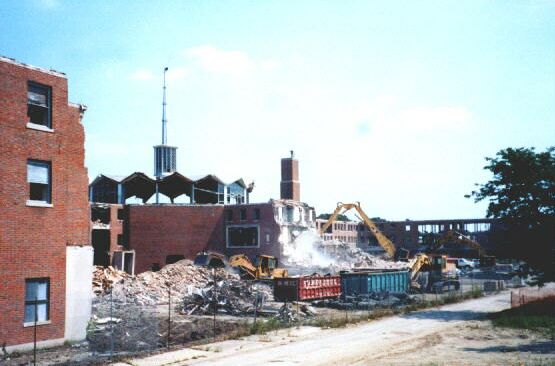
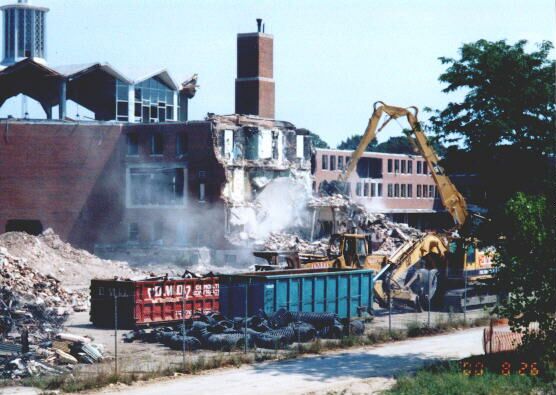
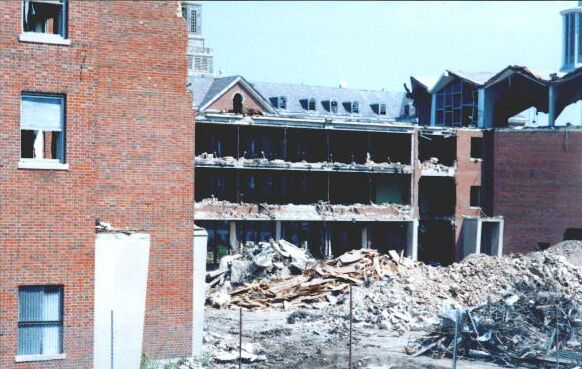
Demolition Leaving Only Memories of Maryknoll
by Judith Cookis, Daily Herald, 24 August 2000
Warren Roth remembers Maryknoll in its heyday. The former seminary
campus, which began to fall to demolition crews Wednesday, is now an
almost unrecognizable pile of rubble, weakened over the years by
fires, floods, and vandals. But in 1949, when the school opened on
the site of an old golf course, it was a pristine, spiritual place,
said Roth of Naperville, one of about 120 men in the school's
inaugural class. After being ordained a priest Roth returned to the
college as an anthropology professor in 1964. "I'm originally from
New York, but I got to like the Midwest a great deal. I made many
lasting friends there," he said.
"The students at Maryknoll were very good students." Brother Adrian
Mazuchowski also studied at Maryknoll betwcen 1950 and 1952. He, too,
remembers a pleasant, country setting, with rolling hills where town
houses now stand. Builders left part of the golf course intact, and
students took to the links occasionally, Mazuchowski said. The
feeling of community was strong and enrollment was high, he added.
"We were getting 100 freshmen a year ... We had 500 live-in students,"
Mazuchowski said.
Roth joined more than a dozen former students at the abandoned site
four years ago for a reunion. To their horror, they found a decaying
structure. "The building we had fond memories of had been left to
fall apart," Roth said, who agreed demolition was the only option.
"It had to come down. It was looking so bad," Roth said. "What really
got me was the satanic symbols in the chapel .
When the Maryknoll Society left Glen Ellyn in the early 1970s, the
building became a law school. After that, the sprawling, 25-acre site
was slated to be a retirement community, but the idea never
materialized. The park district bought the property last year and
plans to turn it into a park with playing fields.
Crews on Wednesday attacked the west end of the H-shaped structure,
chipping away at the newest wing, built in the 1960s. Special
machines, purchased by the wrecking company especially for this
project, use claw-like arms to break off pieces of the red brick
exterior and cut through walls. "It just chews it up," said Dominick
DiSilvio, general manager of DMD Services, the wrecking company.
The original building, with its distinctive bell tower and cross, will
come down last. "When they get to the (original part), they'll have
trouble," Roth predicted. "The architect (a former priest) told us
it's built for 200 years."
There was little fanfare marking the building's demise Wednesday. Even
the curious ghost busters, who have visited the spot rumored to be
haunted by the ghost of a "stay-behind" priest, stayed away. "No,
there's been no ghost sightings," joked Di Silvio. Besides a time
capsule discovered in a cornerstone of the building in February,
officials say they have unearthed no other surprises.
Demolition is expected to be completed by Christmas, park officials
said. A few neighbors in the adjoining Maryknoll Estates subdivision
watched the progress Wednesday. It's all finally coming together,"
said Wendy Durkin, whose backyard faces the original building. We're
delighted. It's going to be beautiful."
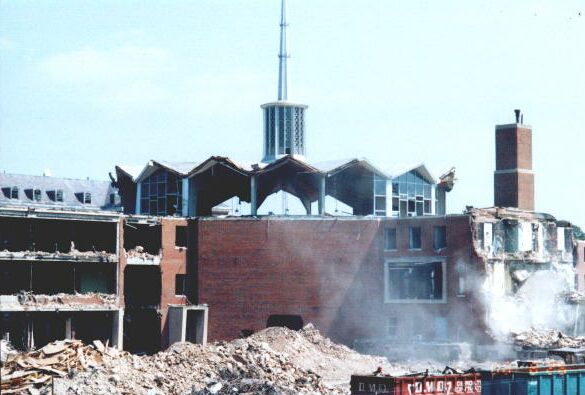
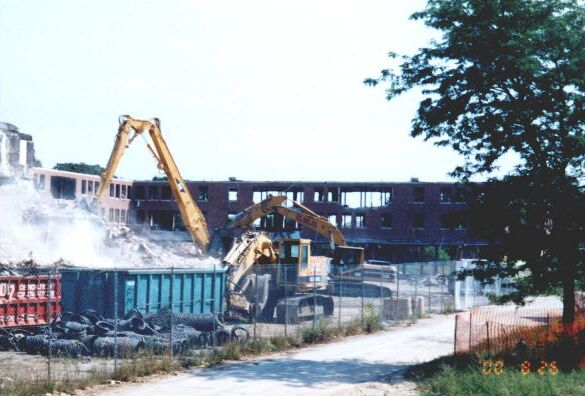
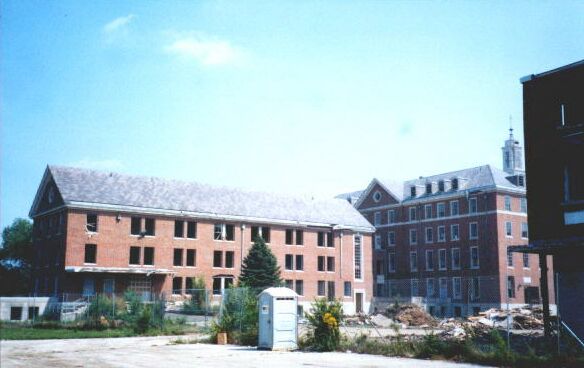
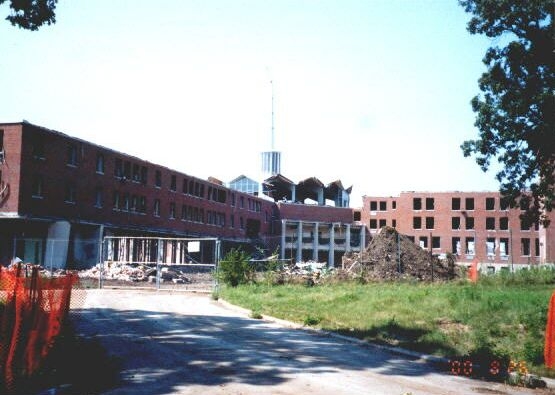
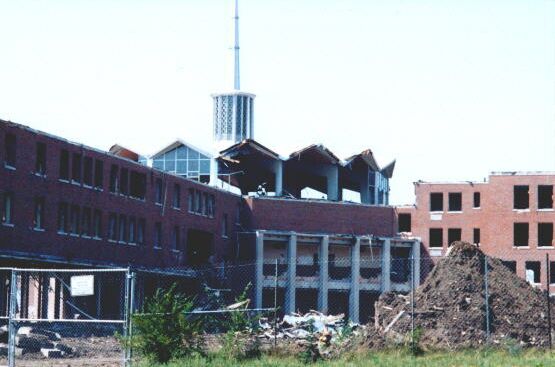
Uncovering the Haunting of Maryknoll
by Bill Jablonski, The Glen Ellyn News, 27 July 2000
"Maryknoll is probably not haunted anymore." Disappointing news to
real-life ghost-hunter and president of Ghost Research Society Dale
Kaczmarek.
As part of a recent, small expedition, Kaczmarek, who was featured on
The Discovery Channel's "Real Ghost Hunters," went to see if the
abandoned Catholic seminary buildings are home to some supernatural
activities. "Ghosts like to associate themselves with living
persons," said Kaczmarck, who has been tracking ghosts for over 25
years. "With a place like Maryknoll or anyplace that has structural
changes going on, we notice a change in spiritual paranormal
activity."
Set for demolition at the end of this month, the 25-acre Maryknoll
site was purchased by the Glen Ellyn Park District to make way for the
possibility of additional baseball fields. Demolition, which
originally was slated to begin in mid-July, is expected to last up to
six months.
Legend has it that on different occasions, Maryknoll seminarians and
faculty had encounters with a "phantom priest" inside of the photo
lab's darkroom. One student photographer alleged a feeling of being
watched while working in the tab and then feeling a strong, cold hand
gliding along his back. He also noticed the sudden, inexplicable
temperature change of his photography chemicals.
Later, in researching photo files with a colleague who had a similar
experience and a sighting of the ghostly figure, the fellow student,
with much certainty, had hand-picked a photograph of a deceased
priest. After discussing the incident with other students the pair
discovered that the photography chemicals they were using had once
belonged to that very priest.
Vacated in 1971 by the seminary due to the rising costs of operations,
the site was later converted into a law school for Lewis University in
1974. The school eventually moved, also due to cost of maintaining the
buildings. In 1986, a Boston company called Elder Care Services was to
turn the property into a senior citizen's retirement community, but
that never materialized. Some say the spirits occupying Maryknoll
could be the reason why these events came to pass.
Ghost-hunting enthusiast Melissa Vola feels different. "The spirits
are not holding back the demolition," said Vola. "I do think it's
possible that when they start, the workers involved in the demolition
might experience some unexplained activity." Vola believes it would
not be unusual to have a haunting during that period of time with such
occurrences as objects levitating, and cold spots. "My advice to them
would be to be very careful," Vola said. "Use extra care."
Kaczmarek agrees that as the impending doom of Maryknoll begins, this
may cause the dormant structure to become a bit more lively with a
little help from the Great Beyond. "The people who used to live there
may be ghosts now and be upset that the place is being torn down,"
said Kaczmarek. "I wouldn't be surprised if there is some activity
down there."
Kaczmarek has an Internet site that covers
his extensive experiences, including documented accounts and a
collection of various ghostsighting photos.
Ghost Hype
Graduate Albert Waszok, who attended Maryknoll from 1967 to 1971,
equates the ghost hype with "telling spook stories around a campfire."
"There were always people talking about it," Waszok said. "But they
were just stories going from one to the next." Waszok does however
recall hearing one story in 1966 of an old medicine room that was
supposedly haunted. The room was in an attic section of one of the
older buildings dating back to 1949.
According to rumors Waszok heard, the room, which was used to store
pharmaceuticals being sent out to missionaries, was haunted by someone
or something. At one point students confided their story to a
Maryknoll priest from Latin America who then allegedly went up to the
medicine room to perform an exorcism.
The Glen Ellyn News contacted that priest to inquire about Waszok's
claim. Father Rafael Davila, who is now Maryknoll's spiritual
director in Houston, Texas, was a student of the seminary here from
1949 to 1953 and a priest from 1960 to 1969. Although refuting any
speculation of ever performing an exorcism in the medicine room,
Davila, who admittedly says his memory is not that of a younger man,
does not dismiss students' accounts of the room being haunted. "if
students came to me with strange things going on, I would have gone
and given a blessing. I could see myself going there and giving deep
respect and saying prayers and giving blessings."
The 69-year-old priest, who taught Spanish and French at the time,
said he would take what the students were saying regarding haunting
very seriously. "The church is usually very sober and skeptical of
that," stated Davila. "At the same time, we do believe in a spirit
world, in Guardian Angels, and evil spirits. So we respect that."
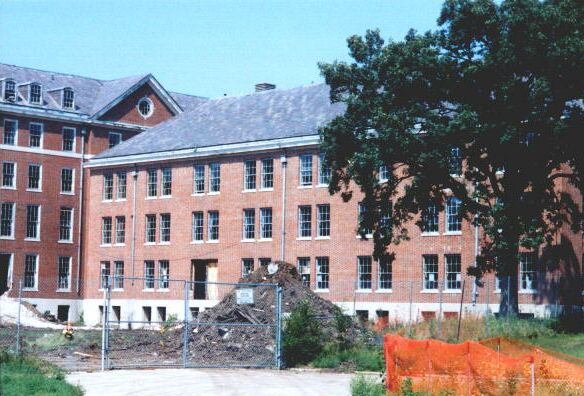
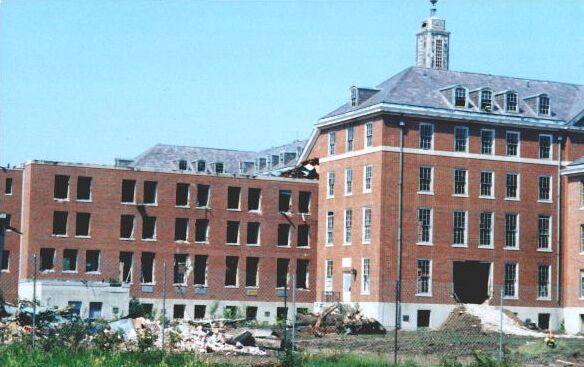
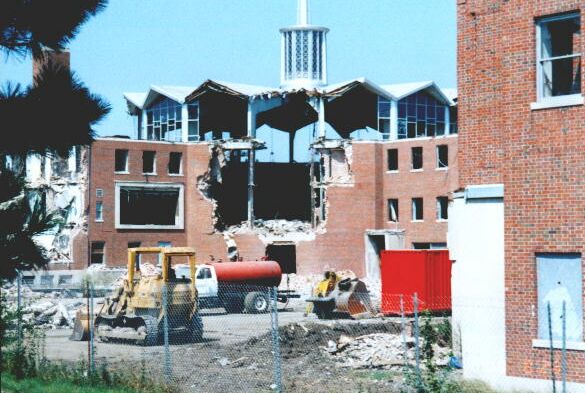
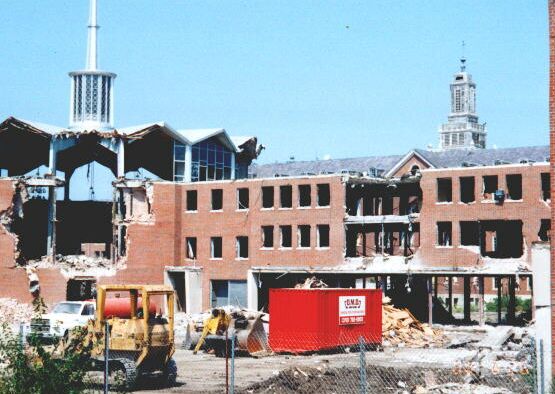
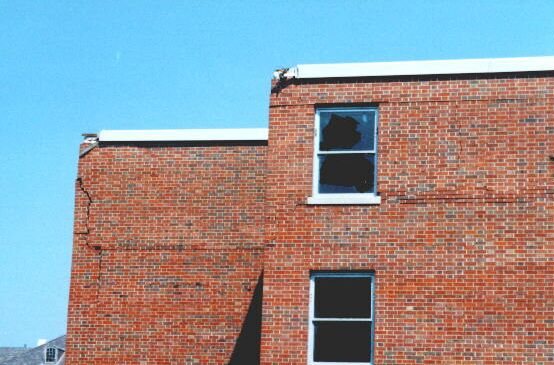
Maryknoll bell tower falls to demolition
by Victoria Pierce Daily Herald, 25 October 2000
The early morning fog hid the change, but by Tuesday afternoon it
became apparent. The bell tower of the Maryknoll Seminary, long an
area landmark, was no more.
"I was just coming by on the expressway and for the first time I
couldn't see the steeple," said Bill Keenan, a Maryknoll Estates
resident who was watching a giant crane rip apart the building like a
dinosaur devouring its prey. "Things have changed," he said.
Watching the demolition has become a favorite pastime for several area
residents. "It's one of those landmarks you hate to see go but you
saw it deteriorate," said Carole Lisson, who also lives near the
abandoned seminary. Her husband came to the seminary for some
training when he was 9 years old. And her grandfather used to golf
here before the seminary was built in the 1940s. Back then a round of
golf cost 10 cents and public transportation from Oak Park was 5
cents, Lisson said.
Some may be surprised that the stately old building is only about 52
years old. With hundreds of large windows, arches, and decorative
masonry it looks more like it was built in the 1840s rather than the
1940s. "It was built to last 200 years," said Dominick DiSilvio,
general manage of the wrecking company, DMD Services.
The bell tower was the most prominent feature of the landmark. It came
down about 6 P.M. Monday evening. "It just kind of hung there for
awhile and they smacked at it until it fell down," said Carol Galla,
who also lives nearby and sat with Lisson and neighbor Gay Goodwin as
the demolition continued Tuesday afternoon. "It's one of those things
it's addicting to watch," said Lisson, as the crane deftly pulled at
some steel roof beams and tossed them to the ground like toothpicks.
"He's an artist," local resident George Graham said of the crane
operator as a cascade of bricks and glass fell at the touch of the
machine's mouth. "Little kids, especially little boys, would love to
watch this .... It's very similar to being devoured by an animal,"
Goodwin said.
The fascination was bittersweet. Goodwin said adjacent residents are
happy to see the sunsets for the first time now that part of the
building is gone. And they are looking forward to the 25-acre park
that will take its place in the coming years. But neighbors will also
miss the presence of the solid building that gave their neighborhood
its name.
But it was time for it to go. The seminary was vacant for 15 years and
had not been fully used since the mid- 1970s when the Maryknoll
Society closed its college and left Glen Ellyn. Lack of care had taken
its toll. "It was always pretty from a distance. But up close you
could see some of the problems," Graham said. "It's going to take some
getting used to."
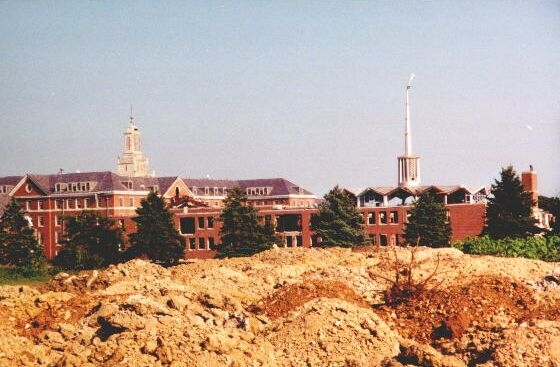

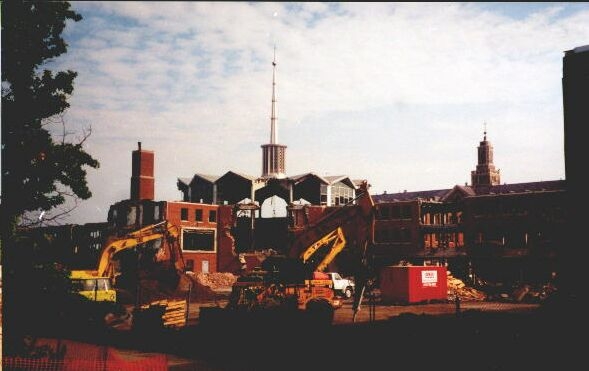
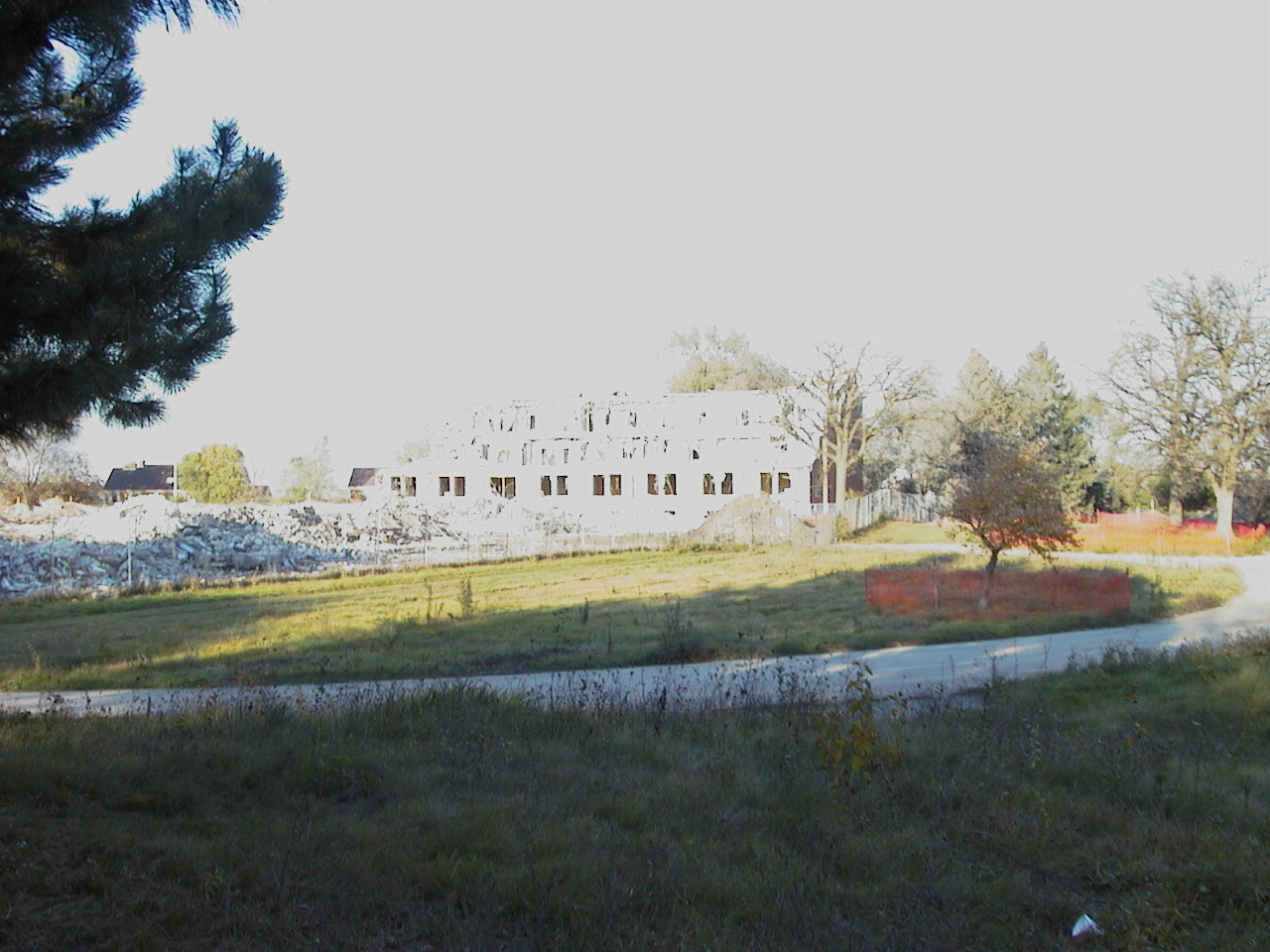
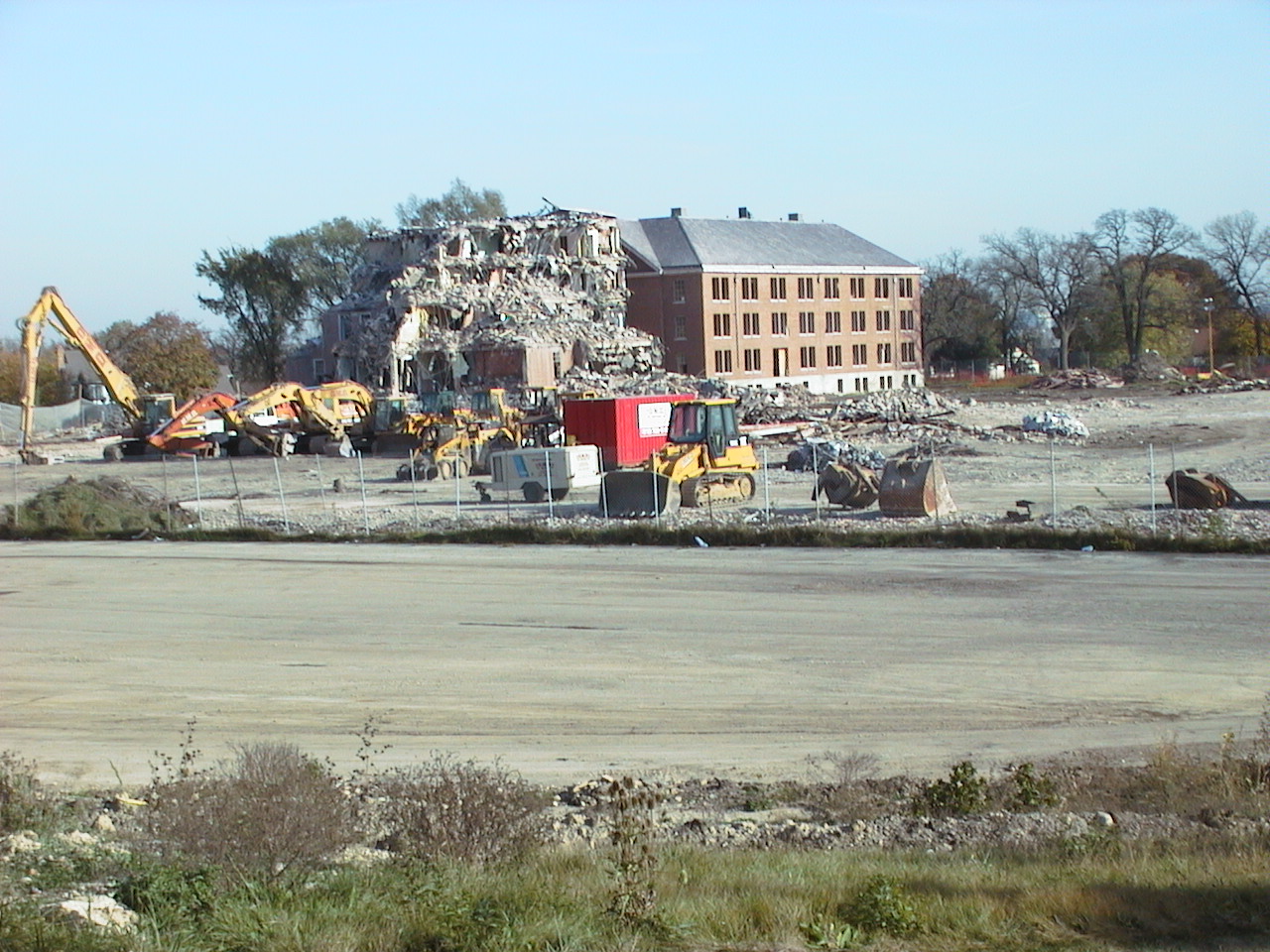
GE park board considers 2 plans for Maryknoll site
by Harry Hitzeman, Daily Herald, 10 January 2001
Glen Ellyn park leaders have the first two visions of what can become
of the former Maryknoll Seminary. Two landscape architecture firms
presented the park board Tuesday night with their plans for the
25-acre site, southeast of Route 53 and Pershing Avenue.
The first plan, hatched by the Chicago-based Teng & Associates,
contained a wealth of recreational activities, including an outdoor
climbing wall, a driving range, a skate park, tennis courts, baseball
diamonds, a sculpture garden, par-3 golf holes, and a concession area
with banquet facilities. "These are illustrations of how we would work
with you as opposed to 'Hire us, we have the right idea all
ourselves'", said Allen Morris, of Teng & Associates.
The second proposal came from Grayslake-based 3D Design Studio. It
featured two full-sized baseball diamonds, two soccer fields, a
playground, batting cages, adventure golf, and a safety town. Walking
paths wrapped around the park, resulting in more green space than
Teng's plan.
The proposals contained several similarities, each suggested by the
park planners: soccer and baseball fields, a sculpture walk and
elements that generate revenue.
The park board will view four more proposals in upcoming months before
hiring an architect. Overall, commissioners said they were pleased
with the plans, but they did not offer any ringing endorsements. Board
president Keith Schoen said the board must balance between serving the
surrounding homes and the entire village. Marty Durkin, who lives near
Maryknoll and is running for park commissioner in April, agreed. "I
view this as a park for the village and a park for the neighborhood,"
Durkin said. The district bought the site for $5.3 million, with help
from a $2 million grant from Gov. George Ryan's Illinois FIRST
infrastructure program and a $1 million loan from the village.










 GE2000demo
GE2000demo









